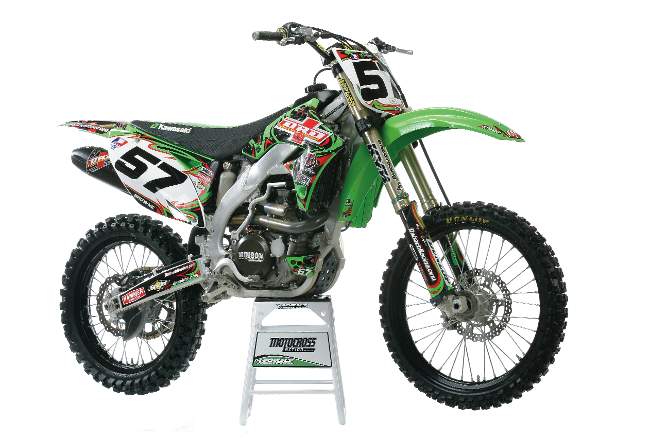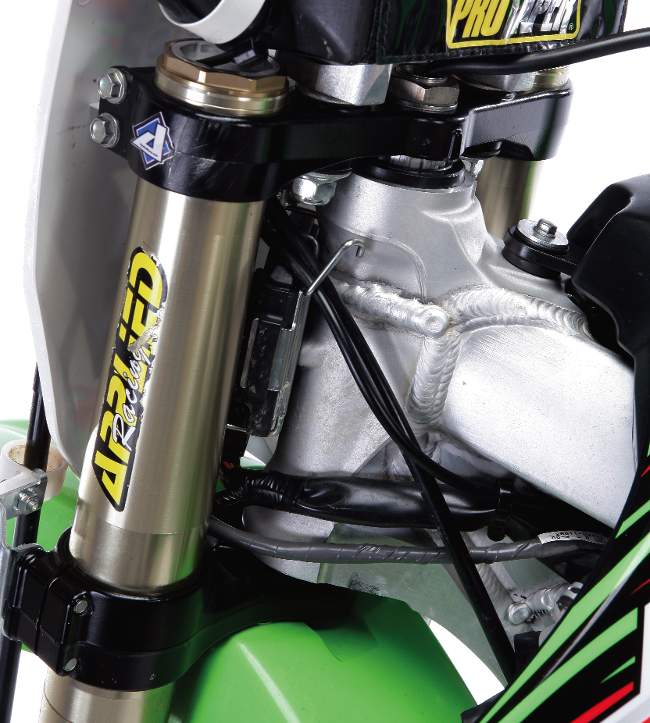WE RIDE JARRED BROWNE’S DR.D KAWASAKI KX450F:

In this struggling economy, the motorcycle industry and motorcycle manufacturers have had to cinch their purse strings tight. When the power elite don’t have any money, it quickly trickles down through the ranks. Race teams have had to pinch pennies, and many professional racers, who a year ago were lighting cigars with $20 bills, now consider themselves lucky to have a ride for 2010. Guys who didn’t get picked up by teams had to either put their own deal together, hustle for any kind of sponsorship or get a day job.
You don’t need a magic eight ball to see who truly has the desire to race. The guys who want it are there when the season starts?even if they have to pit out of a pickup. You can’t blame the pros who feel compelled to drop out because they aren’t making enough money; nor can you blame the aggressive young guns who jump in to fill their spots. And that is where Jarred Browne takes his place on the line.
Jarred’s parents, both motorcycle riders, put their son on a bike when he was three. Living close to SoCal’s Starwest Raceway, Jarred progressed in skill and rose through classes. Jarred says he never aspired to be the “next big thing” or make a career out of racing. He was motivated to advance by his love for the activity. He rode with Suzuki’s amateur team before turning pro for the 2008 outdoor AMA Nationals. In another surprising move, Jarred skipped the 250 class and went straight to the 450s, but injuries and limited sponsorship made learning the ropes in the premier class very difficult.
A serious head injury put him out for most of the 2009 Supercross series and the first three 450 Nationals. Making matters worse was the fact that he didn’t have a ride. Then, out of the blue, Suzuki City asked him to fill in for the injured Matt Goerke. Jarred started to hit his stride and began creeping into the top ten. Highlights included a fifth-place finish in the second moto at the 2009 Washougal National and a consistent 9-9 at Unadilla. But despite those solid performances, Jarred once again found himself without a ride for 2010.
DR.D sponsors complete race teams and didn’t have any plans to sponsor individual riders in 2010. Their concept, as in years past, was to sponsor existing teams to showcase their products at the pro level. But, by the time DR.D realized internal personnel complications had prevented team sponsorship deals from materializing, it was too late. Still, DR.D takes their “R” seriously, so they went looking for a racer?that rider was Jarred Browne.
SHOP TALK: WHAT DIDN’T THEY DO?
Browne’s machine is a credit to the competitive level of current OEM bikes, because it’s not drastically different from what’s on the showroom floor. Without much time to plan, DR.D purchased a slightly used 2009 Kawasaki KX450F. The bike had been a factory test bike?but, in one of those twists of the motorcycle business, it was a test bike that didn’t belong to Kawasaki. Nope. It was Yamaha’s KX450F. With the bike in the DR.D race shop, it was efficiently and affordably turned into a Supercross bike by making only a handful of changes.
Clutch: The most expensive part on the bike is the full Hinson clutch (basket, inner hub, pressure plate, fibers, steels, springs and cover). The investment is here because Supercross pros need to be able to engage and disengage power with as much precision as possible.

DR.D didn’t plan on fielding their own rider for 2010 Supercross series, but they saw an opportunity with Jarred Jet Browne.
Exhaust: Supercross tracks beg for a powerband that is healthy off the bottom. To get the grunt he was looking for, Jarred spent time testing exhaust options with Doug Dubach. A prototype header was developed that had plenty of oomph off the bottom, while a resonance chamber was added to help pass the AMA’s 94 dB sound test. As a side note, the DR.D resonance chamber-equipped header will be produced and available to the public soon. Jarred and DR.D also tested a variety of muffler end caps to see if they could tune the power to suit Jarred’s tastes.
Gearing: Equally important for that low rpm burst is a 52-tooth Pro Taper sprocket on the rear, which is two more teeth than stock.
Suspension: Perhaps most important is the suspension. The job of getting the stock equipment to handle peaky jumps and pound through giant whoops was entrusted to Enzo. Enzo has been Doug Dubach’s suspension supplier for decades, so it was only natural that Doug would hook Jarred up.
Tires: The Dubach connection has other pluses. Since Doug is Dunlop’s test rider, he was able to get Jarred hooked up with Dunlop works tires. The most unobtainable part on Jarred’s bike is the Dunlop 715F front tire. Visually, the tire’s flat knobs (with square recesses for extra biting edge) point to hardpack performance, and we see this tire on Supercross bikes regularly. You need connections to get this tire, but you can go straight to your local shop and buy the MX51 Jarred had on the rear.
Triple clamps: The most attainable part on Jarred’s bike is the stock triple clamps with Applied stickers on them.
Controls: As a tall, lanky rider, Jarred opted for the taller Windham/RM Mid-bend Pro Taper handlebars. The footpegs were from Pro Circuit with the teeth sharpened to a point. Also helping to prevent Jarred from slipping around on the bike was a One Industries gripper seat.

These are OEM triple clamps, but the Applied stickers look nice.
TEST RIDE: HANG ON AND HANG IT OUT
Out on the track, the most impressive thing about Jarred’s bike was its instantaneous throttle response. The fuel injection, bottom-end tuned DR.D pipe, lower gearing and Hinson clutch all work together to give the bike an instant burst. MXA test riders could leap out of sharp turns and launch over jumps from the inside line. With the Hinson clutch, metering that power was easy. An advanced rider with precise clutch and throttle control could really appreciate the accuracy and predictability of this smoothly engaging/disengaging clutch.
For average guys, just riding a pro’s Supercross suspension can necessitate a trip to the chiropractor after the race is over. Jarred’s Enzo setup was very firm, but definitely not the worst we’ve ridden. As with most Supercross suspenders, the forks were significantly stiffer than the shock.
Jarred says he is happy with the overall power of the KX450F (even though the only engine mod is an exhaust pipe). We can’t argue, because the KX450F engine is awesome in stock trim. For outdoor motocross, the trade-off for bottom-end power over top-end pull would hurt on long straights, but for Supercross that part of the powerband is generally reserved for panic-revving situations.
For average guys, just riding a pro’s Supercross suspension can necessitate a trip to the chiropractor after the race is over. Jarred’s Enzo setup was very firm, but definitely not the worst we’ve ridden. As with most Supercross suspenders, the forks were significantly stiffer than the shock. Consequently, the forks didn’t utilize very much of their travel over the little stutter bumps. The suspension was definitely at its best for our testers on big obstacles and hard landings where it absorbed everything we threw at it.
Ergonomically, MXA‘s taller-than-average test riders were very comfortable on Jarred’s bike. All the controls were neutral, and a few millimeter taller bars made standing a lot more comfortable. We also liked the traction of our feet on the wide, sharpened pegs, and our posterior on the gripper seat. Overall, Jarred’s setup was easier to adapt to than most factory riders’?who have slowly drifted into another realm in setup (and not in a good way).

The full Hinson clutch assembly was the most expensive modification to Browne’s bike. The proof was at our fingertips.
WHAT DO WE REALLY THINK?
Jarred Browne’s Dubach Racing KX450F reminded us of what the sport is really about. As racing fans, we love to root for underdogs like Jarred Browne. With flashes of brilliance, like finishing fourth in his heat at the San Francisco Supercross, we expect good things to come. As exhaust pipe customers, we’re excited that some of DR.D’s development feedback comes from a pro on a relatively stock bike. As mechanics who are constantly tinkering with our bikes to figure out the best mods, we were thrilled to see that a stock engine (with a pipe) was good enough to make a Supercross main. As racers, we’re reminded that cubic dollars don’t make you faster (although they do make your wallet lighter).
For more information, go to www.dubachracing.com.




Comments are closed.